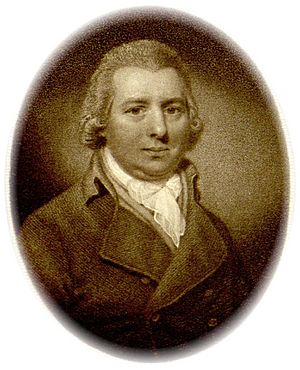William Curtis facts for kids
Quick facts for kids
William Curtis
|
|
|---|---|

Portrait from Curtis's Botanical Magazine
|
|
| Born | 11 January 1746 |
| Died | 7 July 1799 (aged 53) |
| Known for | Curtis's Botanical Magazine |
| Scientific career | |
| Fields | Botany Entomology |
| Institutions | Chelsea Physic Garden, London |
| Author abbrev. (botany) | Curtis |
William Curtis (born January 11, 1746 – died July 7, 1799) was an English expert in plants (a botanist) and insects (an entomologist). He was born in Alton, Hampshire, which is now home to the Curtis Museum.
Contents
William Curtis's Early Life
William Curtis first worked as an apothecary, which was like a pharmacist who also prepared medicines. But he soon became very interested in plants and all kinds of nature. He wanted to share his knowledge with more people. When he was just 25, he wrote a book called Instructions for collecting and preserving insects; particularly moths and butterflies. This book helped many people learn about insects.
A Passion for Plants and Gardens
From 1771 to 1777, William Curtis worked at the famous Chelsea Physic Garden in London. He was in charge of showing people the plants and managing the garden.
After that, he decided to create his own plant garden in London. He opened it in Lambeth in 1779. Later, in 1789, he moved his garden to Brompton.
Publishing Nature's Beauty
William Curtis also loved to publish books about nature. He wrote a big work called Flora Londinensis. This book had six volumes and was published between 1777 and 1798. It was special because it focused on the plants found in the city of London.
Even though Flora Londinensis didn't make him a lot of money, William Curtis didn't give up. In 1787, he started a new magazine called The Botanical Magazine. This magazine became very popular! It featured beautiful, hand-colored pictures of plants. Artists like James Sowerby and Sydenham Edwards drew many of these amazing illustrations.
The Botanical Magazine was a huge success. William Curtis once said that his publications brought him "pudding or praise," meaning they brought him either money or fame.
His Lasting Legacy
William Curtis's work left a big mark on the world of botany. A type of plant, the genus Curtisia, was named in his honor.
His famous magazine, Curtis's Botanical Magazine, is still published today! It is one of the most respected magazines about plants. Many famous natural history artists, like James Sowerby and Sydenham Edwards, started their careers by drawing for this magazine.
William Curtis was buried in the churchyard of St. Mary's Church, Battersea. There is a special stained glass window there that remembers him. He collected many plant samples from that very churchyard.
His headstone, which is now lost, had a poem written on it:
While living herbs shall spring profusely wild,
or gardens cherish all that's blithe and gay,
So long thy works shall please, dear Nature's child,
So long thy mem'ry suffer no decay.
When botanists talk about plants that William Curtis named, they use the short name Curtis to show he was the one who described them.


